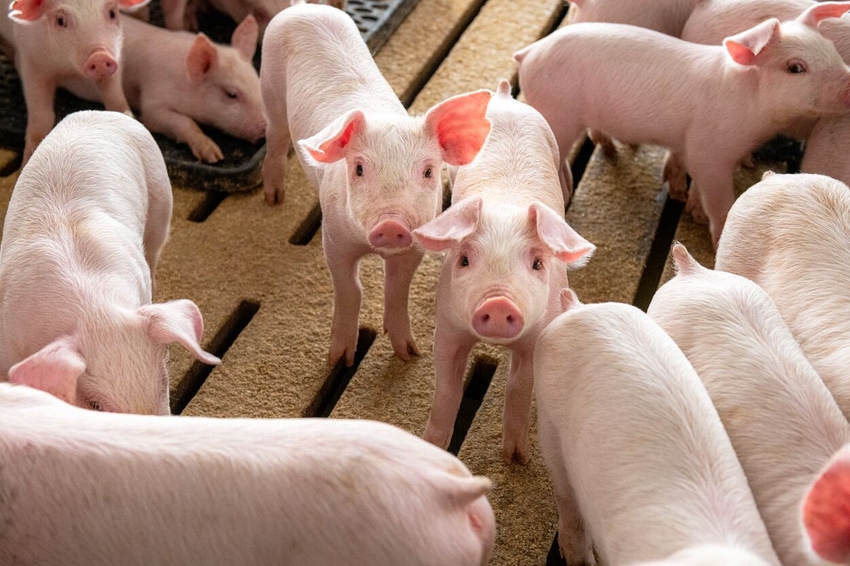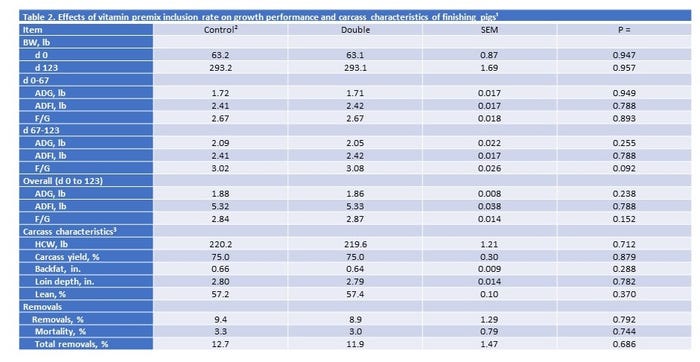Vitamin premix inclusion rates evaluated in commercial finishing pigs
Objective to determine the effect of increased inclusion of a vitamin premix on grow-finish pig growth performance, and carcass characteristics.
May 11, 2023

Vitamins are required primarily as coenzymes in nutrient metabolism for physiological functions such as maintenance, growth, development and reproduction. Some vitamins are synthesized by the pig or are present in feed ingredients commonly used in swine diets to meet requirements. However, several vitamins need to be added to swine diets in the form of a vitamin premix to avoid deficiency and obtain optimal performance. The quantity of added vitamins may be substantially higher than the requirement because vitamins can lose potency during storage and feed processing.
Surveys of U.S. nutritionists by Flohr et al. (2016) and Faccin et al. (2023) showed that many swine nutritionists in the United States fed vitamins at 2 to 6 times the NRC requirement estimates to growing-finishing pigs. In addition, a similar survey showed that the Brazilian industry is feeding 3 to 6.5 times NRC requirement estimates (Dalto et al., 2020). As a result of a shortage in the vitamins supply chain in 2017 and an increase of vitamin prices, some nutritionists decreased the vitamin levels of premixes to reduce cost. However, many did not return to the original inclusion levels once availability increased and costs were reduced. Therefore, the objective of this study was to determine the effect of increased inclusion of a vitamin premix on grow-finish pig growth performance, and carcass characteristics.
A total of 1,080 pigs (337 × 1050, PIC; initially 63.1 ± 0.87 lb) were used in a 123-d growth trial. Pigs were housed in mixed gender pens with 27 pigs per pen and 20 pens per treatment. Daily feed additions to each pen were accomplished using a robotic feeding system (FeedPro; Feedlogic Corp., Wilmar, Minnesota) able to record feed deliveries for individual pens. Pens of pigs were assigned to one of two dietary treatments in a completely randomized design and consisted of corn-soybean meal-based diets with the current KSU Vitamin Premix (Table 1) included at 3, 2.5, 2 and 1.5 lb per ton for phase 1, 2, 3 and 4, respectively, or the same premix added at double the rate in each phase. Experimental diets were fed in meal form with phase 1 fed from 63 to 110 lb, phase 2 from 110 to 160 lb, phase 3 from 160 to 220 lb and phase 4 from 220 to 293 lb.
The study was conducted at a commercial research-finishing site in southwest Minnesota. The barn was naturally ventilated and double-curtain-sided with totally slatted floors. Each pen was equipped with a five-hole stainless steel dry self-feeder and a bowl waterer for ad libitum access to feed and water.
From d 0 to 67, there was no evidence of differences in ADG, ADFI or F/G between the treatments (Table 2). However, from d 67 to 123, there was a marginal response in F/G with pigs fed the current vitamin inclusion rate having better F/G, but no evidence of differences in ADG and ADFI was observed. For overall growth performance (d 0 to 123), there was no evidence of differences in ADG, ADFI and F/G between the treatments.

When evaluating carcass characteristics, no evidence of differences was observed in hot carcass weight, carcass yield, backfat thickness, loin depth and percent lean. Mortality and pigs removed from the study due to poor growth were not different between the two treatments.
In conclusion, this study provides evidence that feeding twice the normal inclusion rate of a vitamin premix tested (KSU recommended specifications) had no impact on overall growth performance, mortality or carcass characteristics for these commercial growing-finishing pigs.
The full data is available in the 2022 K-State Swine Industry Day Reports.
You May Also Like



